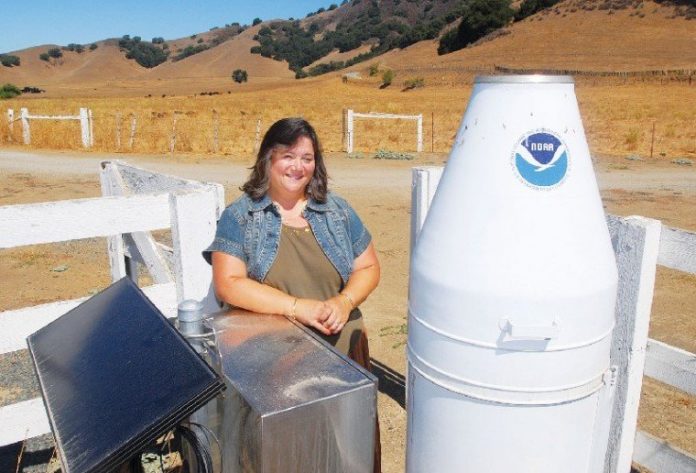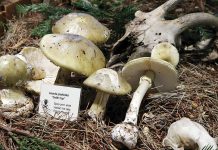Winding through the Diablo Range, Lisa Ladd points out green
bell peppers littering the shoulder of Ca
ñada Road. She brakes to let a tarantula cross.
By Sara Suddes Special to The Dispatch
Gilroy – Winding through the Diablo Range, Lisa Ladd points out green bell peppers littering the shoulder of Cañada Road. She brakes to let a tarantula cross. It’s a bucolic South County scene, complete with grazing cattle, soaring raptors and a National Oceanic and Atmospheric Administration weather station.
Although Ladd’s grandfather, Henry Mantelli, died in 2002, Ladd still visits the ranch often, at least once a month to continue collecting readings from the NOAA instruments located on the property. Just one of many interesting features of Mantelli Ranch, the NOAA instrument, known to the National Weather Service as “Gilroy 8NE,” has been positioned on the property since 1966.
The NWS collects meteorological observations across the country to record the climate conditions in the United States. The NWS relies on a network of observers across the country who volunteer their time to take daily or monthly readings of rainfall totals. Mantelli faithfully maintained Gilroy 8NE for more than 35 years, contributing invaluable information to the NWS. Because of volunteers like Mantelli, the NWS can piece together a comprehensive climate record for the whole country.
Granddaughter Ladd has now taken over Mantelli’s duties and makes her monthly vigil to the weather station to take this month’s reading.
“Dry as a bone,” she declared. The process of taking a reading is relatively simple. The rainwater falls into a collection barrel, then weighed and the data is sent to a computer readout screen that is powered by solar energy. Ladd then downloads the data onto a flash drive she sends to the Bay Area Weather Forecast Office in Monterey.
But for Ladd, the ranch is more than a site for NWS research. It’s a family tradition. She gestured to the bell peppers on the shoulder of the road.
“We used to bring up the damaged ones to feed the cattle,” she said, referring to the peppers. Spending the summers of her youth at Mantelli Ranch with her grandparents, Henry and Carla, Ladd learned from an early age that nothing goes to waste and everything can be used a second time around.
She also learned to appreciate a lifestyle that is diminishing in a world of big business and mass production. Her grandfather, owner of Mantelli Ranch, played a strong role in her upbringing. A man with stories to tell, Henry Mantelli shared his life with his grandchildren.
“My grandfather was a rancher in a time when cowboys were like John Wayne,” Ladd said. “Today, it’s a lost livelihood. Certain things, like the branding of the summer cattle, were a big event. It’s not like that anymore.”
Henry Mantelli – a Shriner, a Mason and an Elk – instilled in his grandchildren a sense of community and appreciation for nature. He began his career as a pharmacist in Berkeley, but later purchased an orchard and moved south to Mountain View, growing cherries, apricots and plums. Later, he and his wife continued south and moved onto what is now Mantelli Ranch, in 1958. During his 44 years at the ranch, Mantelli lived a life that is practically nonexistent anymore, Ladd said.
“My lament is that my children will never know what it’s like to grow up on a ranch the way I did,” Ladd said of her son, Nolan, 12, and her daughter, Pixie, 8. From the time she was 11-years-old to when she graduated high school, Ladd lived in Hawaii with her parents and her younger brother Bart. But every summer, Ladd was at the ranch, working cattle right alongside her grandfather.
“Hawaii was full of people,” said Ladd, a school teacher of 15 years, now pursuing her paralegal certificate at De Anza College. “There was no solitude there. I basically spent my summers as a hermit at my grandparent’s ranch because I loved it there.”
In addition to the NOAA station, the ranch is also the site of a functioning seismograph monitored by the University of California, Berkeley. Less technologically geared features include a flock of wild turkeys, wild pigs, and the herd of cattle typical of a ranch.
“My grandfather was a character,” Ladd said. “He never said no to anyone. Berkeley wanted to put in a seismograph, NOAA wanted to put in a weather station … His answer was always ‘Sure, why not!’ ”
The ranch is still fully functioning and run by ranch hands that live on the property. It is managed by Ladd’s cousin, Michael Mantelli. Black angus cows graze on the left side of the driveway while an English walnut tree shades a paddock that blooms with daffodils in the spring off to the right. Wild turkeys flock down the driveway.
“I was so fortunate to cash in on America’s idea of a romantic life,” Ladd said, as she observes her surroundings.
Growing up, Ladd and her grandfather discovered many artifacts left over from the Ohlone Indians on the land surrounding Mantelli Ranch. Rich with history, the land is also steeped in tradition. Ladd waves at every passing car on the tiny, winding road. After all, they are her neighbors.














